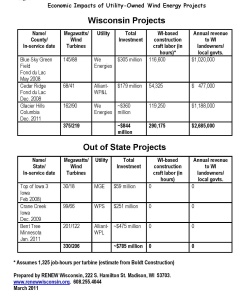Michael Vickerman
Executive Director
608.255.4044
mvickerman@renewwisconsin.org
Less than a month after a 10-member legislative committee prevented a statewide wind permitting rule from taking effect, Invenergy, LLC, a Chicago-based wind developer that owns and operates the 86-turbine Forward Energy Center installation south of Fond du Lac, has ended efforts to install 100 turbines in southern Brown County.
In a March 21 letter to the Public Service Commission (PSC), Invenergy singled out the recent suspension of the agency’s wind siting rule as a significant factor in its decision to cancel the Ledge Wind Energy Center. “The absence of regulatory stability has made it imprudent for Invenergy to proceed with investments in a project which unknown regulations might make infeasible to construct,” the letter states. Invenergy’s application to build the 150-megawatt Ledge Wind project was filed in October 2009.
“The regulatory environment for permitting wind energy systems in Wisconsin is deteriorating rapidly,” said Michael Vickerman, executive director of RENEW Wisconsin. “The rollback started with Governor Walker’s proposal to impose onerous and unworkable setback requirements on wind turbines, and continues with the Legislature’s assault on the PSC’s wind siting rule.”
“By all appearances, it seems that Governor Walker and the Legislature intend to close the door on wind development in Wisconsin once We Energies completes its Glacier Hills project later this year,” Vickerman said.
The PSC rule, which was scheduled to take effect March 1st, would have fulfilled the Legislature’s intent to create uniform siting regulations to replace what had become a restrictive and hodgepodge of local requirements. On that very day, the Joint Committee for Review of Administrative Rules suspended the rule on a 5-2 vote that tracked along party line votes (Republicans in favor; Democrats against).
Had the 150 MW Ledge Wind Energy Center gone forward, it would have generated $600,000 annually in municipal revenues to Brown County and four host townships, and more than $600,000 annually to host landowners and their neighbors. On average, installing one turbine requires 1,325 hours of craft labor, and a 100-turbine wind project will support a payroll of over $10 million, according to figures provided by Boldt Construction.
“Invenergy’s cancellation of its Ledge Wind project should not come as a surprise,” Vickerman said. “It should be expected with a political leadership that treats windpower as a pariah energy source. Until the day the Governor and the Legislature put aside their ideological blinders and recognize the benefits that come with developing a clean, locally available and inexhaustible energy source, Wisconsin will remain a very unappetizing place to pursue utility- scale wind projects.”
“Wisconsin can ill-afford to export windpower-related jobs and local payments to other states,” Vickerman said.
-- END --
RENEW Wisconsin is an independent, nonprofit 501(c)(3) organization that acts as a catalyst to advance a sustainable energy future through public policy and private sector initiatives. More information on RENEW’s Web site at http://www.renewwisconsin.org..jpg)
